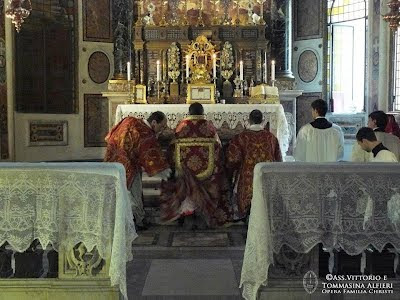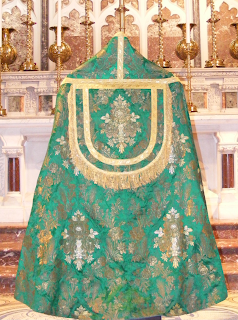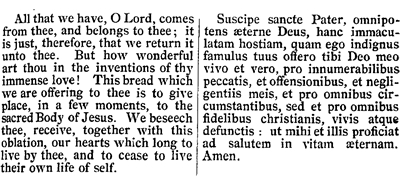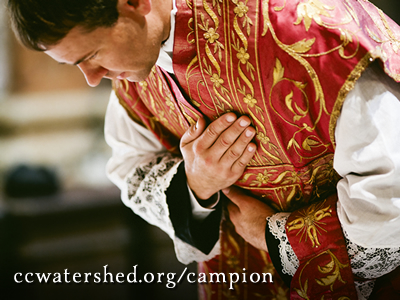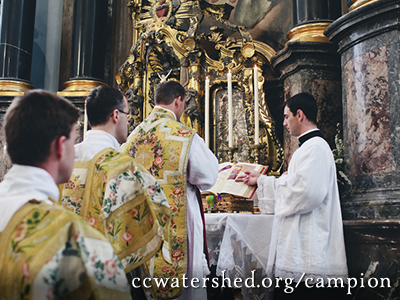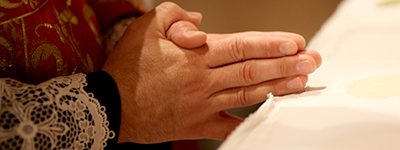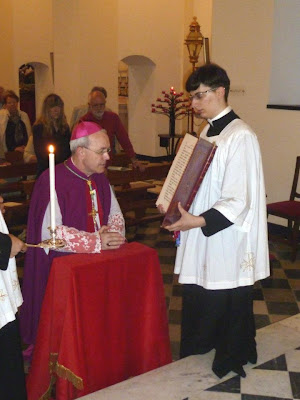[The following was sent in to us by Fr. Guy Nicholls of the Oratory.]
* * *
Pentecost: The Grandest Octave?
“…consider the breviary offices for Pentecost and its Octave, the grandest, perhaps in the whole year…”
(Blessed John Henry Newman)
Last year I read with great interest Gregory Dipippo’s article on the Octave of Pentecost.
In the light of that, and in view of the current liturgical season, your readers may be interested to know of a new initiative taking place this Pentecost at Dorchester-on-Thames, Oxfordshire, England, a church which has featured several times on the NLM website. To this account I have added my own reflections on the importance of restoring the liturgical observance of the Octave of Pentecost.
Whitsunday (i.e. Pentecost Day) was celebrated at Dorchester with a magnificent High Mass in the Novus Ordo, preceded by the solemn singing of Terce in Latin from the pre-1970 breviary (comprising principally the Veni Creator and sections III-V of psalm 118). While the Mass began in the vernacular and was mostly sung, Latin took over from the Pater noster until the end. The Celebrant was assisted by a Deacon and an Acolyte wearing the tunicle. The ordinary of the Mass, Morales’s Missa L’Homme Arme’, was sung by the Newman Consort of Oxford, a group connected with the Ordinariate of Our Lady of Walsingham, who also sang Byrd’s Confirma hoc Deus.
Most fittingly and movingly, two young adults, recently baptized, were confirmed by special indult after the homily. They wore the white robes of the newly baptized, thus illustrating the origin of the familiar English name of this feast, “Whitsunday”, since it was the usual time for the celebration of adult baptism in ancient times in our cold northern climate. After the chrismation, the entire congregation, having renewed their baptismal faith with the candidates in place of the Creed, was sprinkled with baptismal water accompanied by the singing of the Vidi aquam.
Since it seems that such a great feast of the “Birthday of the Church” is more fittingly celebrated over an extended period than is allowed for in the single day of the 1970 Missal, the Octave of Pentecost is currently being celebrated at Dorchester as a series of votive Masses of the Holy Spirit, but with some important differences.
In accordance with the Holy Father’s mind expressed in Summorum Pontificum, that the two forms of the Roman Rite should be mutually enriching, the Octave is being celebrated largely in the Ordinary Form, though using significant elements drawn from the Masses of the pre-1970 Octave. The Proper chants of the Masses of the pre 1970 Graduale, and particularly the Alleluia and its Sequence Veni sancte Spiritus are sung in Latin. Each day’s readings are those provided in the old Missal, especially extended on the Ember Days of Wednesday and Saturday. In place of the Graduals, for weekday Masses Responsorial psalms have been provided from the current Lectionary to match the particular character of each day.
For instance, Tuesday’s Gospel of the “Door of the sheepfold”, has psalm 22 as a fitting prelude, while Saturday’s long series of Old Testament Readings takes up one of the ancient pre-Christian themes of the Jewish feast of Pentecost, the offering to God of the first fruits of the harvest, for which psalms 64, 106 and 125 are provided in the Novus Ordo lectionary, and so are selected here.
Reflections on the Recovery of the Pentecost Octave
The transition to Ordinary time on the Monday after Pentecost is disjunctive. It is not simply the return to Ordinary time per se that jars, since that must happen at some time anyway. No, the problem that several of your correspondents share with me is the sense that the first green Monday after Pentecost has come from nowhere. In addition to the abruptness of this transition, the ferial days which now follow Pentecost belong to an entirely disconnected sequence that was broken off before Lent and so has no token of continuity with what has immediately preceded it. The transition was formerly more intelligible since the Octave of Pentecost came quietly to an end on Ember Saturday, emerging easily in First Vespers of Trinity Sunday, the beginning of a new week and season, and a feast, indeed, which celebrated and contemplated the mysteries which were fulfilled in the descent of the Holy Spirit "leading the Church into all truth".
What is the effective result of the loss of the Pentecost Octave?
First, it has the most unfortunate effect of reducing Pentecost to a mere end point. Because it is now simply a single day at the conclusion of Paschaltide from which all that follows is discontinuous, Ordinary Time does not seem to succeed Pentecost, but to supplant it. Thus Pentecost now seems only to look backwards to Easter of which it is the concluding celebration, rather than both back to Easter and forwards towards “green time” representing the post-Pentecostal life of the Church until the Second Coming.
Secondly, this rupture and discontinuity is further increased by the nomenclature of "Ordinary Time". While from the designation of "Time after Pentecost" alone the Church might have posited a relationship to that feast (albeit in a different way from "Time after Easter" to Easter Day itself), there was indeed a more than merely nominal connection. Of course Paschaltide is more organically and thematically linked to Easter than is the whole "post Pentecosten" period to Pentecost. Nevertheless the correspondence between Time after Pentecost on the one hand and the entire era of the Church, endowed with the Spirit and awaiting the Parousia on the other, was formerly more manifest in this long "green" period of the Church Year. This was especially clear both at the outset of the season with the Mystery-contemplative feasts of Trinity and Corpus Christi, and at the very end on account of its eschatological Sunday Gospels.
Thirdly, the greatly reduced presence of Pentecost as a one-day wonder leaves a vacuum which the charismatic pentecostalists would seek to fill. Although historically there are many reasons why this movement has grown up within the Church, it cannot be without significance that their non-liturgical character as the would-be standard bearers of a pneumatologically-based devotional life in the Latin Church has coincided with that Church's now very reduced celebration of the Spirit's coming and His role in the Church until the Parousia.
With regard to a pneumatological focus to the liturgy, I find it difficult to see how the pre-Pentecost Novena (as argued by Mgr Bugnini) can adequately replace the weight of the post-Pentecost Octave. Let me admit immediately that I believe that the Masses of the OF for the period from Ascension to Pentecost are admirable in providing that focus on the prayerful preparation for the descent of the Spirit, and is a good example of the ways in which certain aspects of the OF do represent an enrichment from which the EF might well benefit (as does the euchology and lectionary for the entire Paschal season). Still, it has to be granted that a period of preparation is just that: a preparation and not the fulfilment thereof. The Pentecost Octave represents the fulfilment of the outpouring of the Spirit as manifested in the Church's post-Pentecostal life.
To those who suggest that the Church should simply "get on with it" and go straight from Pentecost Sunday to Ordinary Time without any delay, I say that the Octave of Pentecost, far from being a delay in "getting on", is setting the scene for Ordinary Time which follows. Any careful reader of the Masses and Offices of the Octave notes immediately that they are not simply historical reminiscences of aspects of the descent of the Holy Spirit. In fact, the Spirit is not explicitly mentioned in the Gospels of any of the Masses throughout the Octave! The Votive Masses in the Paul VI Lectionary do indeed contain an exhaustive collection of Gospel pericopes which mention the Holy Spirit explicitly, but that is not what the Church was aiming to do in the Masses of the Octave of Pentecost: It is the effects of the Spirit's outpouring that are celebrated in those Gospel passages. Why then did the Church use Gospel passages without reference to the Coming of the Spirit during the Octave of Pentecost? This is, of course, a consequence of the baptismal nature of the Octave, beginning of course with its Vigil. It is that baptismal character which has formed the shape and catechetical matter of the Octave and given it its peculiarly solemn rank, equal to that of Easter alone.
Fourthly, if the character and solemnity of the Pentecost Octave are ultimately connected to the baptismal celebrations of Pentecost, should the Octave continue to exist in the same form as it did until 1970 and should there be two celebrations of Baptism of like solemnity at either end of the same season? If not, then should Pentecost continue to be marked by such a solemn Octave as that which used to give it such splendour?
Regarding the first point, it is arguable that the "doublet" of the Pentecost Vigil as a celebration of baptism is redundant. It can be seen as simply postponing the baptismal ceremony from Easter to a later and warmer time of the year. Yet the Church felt no incongruity for centuries in celebrating both Vigils, even if baptism was celebrated at only one of them in any place at any time. I would argue thence that this “doublet” is not simply a reduplication. As the Latin Church has celebrated the liturgy for most of her history, Easter and Pentecost are both understood as fontal feasts. Both of them in complementary ways are a celebration of sacramental fecundity. The Resurrection and the outpouring of the Spirit should not be treated as reducible to one and the same event, but as successive stages in the one Paschal Mystery in which the Second and Third Persons of the Godhead act specifically according to the salvific will of the Heavenly Father.
To take the second point, viz. If baptism ought not to be celebrated with the same kind of outward solemnity at Pentecost as it is at Easter, then should Pentecost be endowed with an octave of the same rank and character as the avowedly baptismal octave of Easter? This in turn raises the question of the character of the Easter Octave precisely as baptismal. All the Easter Octave Masses have Gospel pericopes drawn from the accounts of the Resurrection appearances. In this respect the character of the Easter Octave, though clearly a Baptismal one from its Introits, prayers and epistles, is more closely allied to the historical event which it celebrates than is the Octave of Pentecost. In fact, from the point of view of the Gospel pericopes, Pentecost has the more clearly post-baptismal liturgical character. Looking carefully at both Octaves it becomes clear that they are united by their baptismal character, but in complementary ways: the first based on the historical event of the resurrection as the originating cause of our salvation, and the second celebrating the outpouring of the Spirit as the means of continually accomplishing this salvation in the Church's sacraments.
Moreover, if all the gifts of the Spirit which are given at Baptism are explicitly celebrated at Easter, why should the Church recognise a need liturgically to celebrate Pentecost at all, and why prepare for it with a Novena following the Ascension?
Fifthly, Pentecost is a feast which demands “resonance” for its importance in the Church's life to be made clear. An octave provides a feast with room to resonate. It is the counterpart to Pope Paul VI's image of the Church bell which rings out before Mass, thereby preparing the faithful psychologically to take part in the liturgy. To extend the image we may say that the earlier the bell rings and the greater the number of bells which are rung, the greater the celebration they announce and prepare the way for. Similarly, just as a great sound needs time to unfold so that its timbre may be appreciated, so too does a great feast. That which is over in one day has little room to resound and gives the impression that it has not much to say to us needing to be heard at leisure. I would argue that a great octave lends proportionate splendour in advance to the feast and to the character of its celebration.
Fimally, it is important also not to forget the Breviary Offices of Pentecost and its Octave, which Blessed John Henry Newman called “the grandest, perhaps, of the whole year” (v. An Essay in Aid of a Grammar of Assent, ch. 5, section 2, “Belief in the Holy Trinity”). These reflections from the Fathers upon the Gospel readings of each day invite us to deepen our assimilation of the mystery of the Life of the Church whose soul is the Holy Spirit (v. Catechism of the Catholic church no. 797).
In summary, the character of Pentecost as a consummation and fulfilment of the Paschal Mystery suggests that it is fitting to celebrate it with an Octave similar in character and rank to that of Easter. Easter looks both backwards to Our Lord's Passion as His “passing to the Father” and forwards to Eastertide as the season in which the resurrection and its meaning for our eternal life is unfolded for us. In a parallel way Pentecost looks both backwards to the promise of the gift of the Paraclete made at Easter and forwards to “Tempus post Pentecosten”, representing the life of the Church under the Holy Spirit's constant guidance and enriched with His lifegiving sacraments.
Guy Nicholls
Cong Orat
June 25th 2011 and 29th May 2012![]()
![]()









